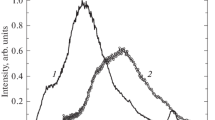Abstract—
The luminescent characteristics of K3LuSi2O7:Pr3+ (1%), which is a promising optical material for the use as a scintillator, have been studied using a set of techniques. The luminescence spectra of K3LuSi2O7:Pr3+ (1%) contain two bands in the UV-range with peaks at 284 and 330 nm, which correspond intraconfigurational 5d → 4f transitions in the Pr3+ ions. The radiation in the visible and near IR range (480–850 nm) has been represented by the intraconfigurational 4f → 4f transitions. The kinetics of 5d → 4f-luminescence contains a build-up stage (τrise ∼ 7–12 ns), nonexponential decay stage (τ1/2 ∼ 60 ns), and a slow component of the μs-range when excited by high-frequency (∼8 MHz) synchrotron radiation of the X-ray range. The fast component of the decay (τ = 54 ns) dominates in the decay kinetics of luminescence along with the build-up stage while the contribution of the μs decay component is less than 0.5% at the excitation by an pulse electron beam (5Hz). The excitation spectra of d–f- and f–f-photoluminescence in the ultraviolet and vacuum ultraviolet range that are measured using synchrotron radiation reveal features that are caused by both intracenter transitions and processes related to the energy transfer from the intrinsic electronic excitations to the impurity center.







Similar content being viewed by others
REFERENCES
A. M. Srivastava, J. Lumin. 169, 445 (2016).
M. Nikl, H. Ogino, A. Yoshikawa, E. Mihokova, J. Pejchal, A. Beitlerova, A. Novoselov, and T. Fukuda, Chem. Phys. Lett. 410, 218 (2005).
K. V. Ivanovskikh, Q. Shi, M. Bettinelli, and V. A. Pustovarov, Opt. Mater. 79, 108 (2018).
A. Zych, M. deLange, C. d. M. Donega, and A. Meijerink, J. Appl. Phys. 112, 013536 (2012).
K. Ivanovskikh, A. Meijerink, C. Ronda, F. Piccinelli, A. Speghini, and M. Bettinelli, Opt. Mater. 34, 419 (2011).
V. A. Pustovarov, J. Surf. Invest.: X-ray, Synchrotr. Neutron Tech. 9, 1168 (2015).
M. Trevisani, K. V. Ivanovskikh, F. Piccinelli, and M. Bettinelli, J. Lumin. 152, 2 (2014).
M. Trevisani, K. Ivanovskikh, F. Piccinelli, and M. Bettinelli, Z. Naturforsch. B 69, 205 (2014).
S. I. Omelkov, V. Nagirnyi, E. Feldbach, R. Martinez Turtos, E. Auffray, M. Kirm, and P. Lecoq, J. Lumin. 191, 61 (2017).
I. Vidican, M. D. Smith, and H.-C. zur Loye, J. Solid State Chem. 170, 203 (2003).
V. A. Rustovarov, E. I. Zinin, A. L. Krymov, and B. V. Shulgin, Rev. Sci. Instrum. 63, 3521 (1992).
V. Yu. Ivanov, V. L. Petrov, V. A. Pustovarov, B. V. Shul-gin, V. V. Vorobjov, E. G. Zinevich, and E. I. Zinin, Nucl. Instrum. Methods Phys. Res., Sect. A 470, 358 (2001).
W. Y. Ching, L. Ouyang, and Y.-N. Xu, Phys. Rev. B 67, 245108 (2003).
ACKNOWLEDGMENTS
The authors express their gratitude for the provided beam time at 4B8 beamline of the Beijing Synchrotron Radiation Facility, China. The experiments with the use of X-ray radiation were partially performed using the infrastructure of the Shared-Use Center “Siberian Synchrotron and Terahertz Radiation C-enter (SSTRC)” based on VEPP-3/VEPP-4M/NovoFEL of BINP SB RAS.
The authors thank Sergey Omelkov (University of Tartu) for his assistance in PCL measurements and E. Viviani (University of Verona) for the help in sample synthesis.
Funding
The work was supported by The Ministry of Education and Science of the Russian Federation (project RFMEFI62117X0012).
Work was executed at partial support of the Ministry of Education and Science of the Russian Federation (the base part of state task, project no 3.8302.2017/8.9), resolution No. 211 of the Government of the Russian Federation (contract no. 02.A03.21.0006), COST action TD1401 “FAST” and project no. RFMEFI62117X0012.
Author information
Authors and Affiliations
Corresponding author
Additional information
Translated by N. Petrov
Rights and permissions
About this article
Cite this article
Pustovarov, V.A., Ivanovskikh, K.V., Khatchenko, Y.E. et al. Luminescence Spectroscopy and Decay Kinetics of Pr3+ Ions in K3LuSi2O7:Pr3+. Phys. Solid State 61, 752–757 (2019). https://doi.org/10.1134/S1063783419050263
Received:
Accepted:
Published:
Issue Date:
DOI: https://doi.org/10.1134/S1063783419050263



